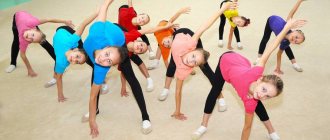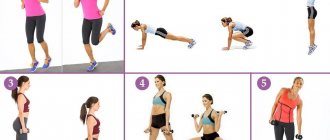JULY 31, 2018
Children's fitness is now represented in many fitness centers and has a variety of directions and types. Its popularity is easily explained - unlike physical education classes at school and sports clubs, in children's fitness, trauma is minimized, there are no contraindications, and you can choose an activity based on the needs of the child, without adapting to the general system. What types of children's fitness exist and why is it so useful for children?
Why do children need fitness?
Today's children can help fill the lack of physical activity necessary for the full development of the body by attending children's fitness classes. This type of fitness is gaining great popularity due to its versatility and the ability to choose a workout based on the needs of the child. What features of children's fitness do parents need to know and how to choose the right workout?
Physical education classes at school do not have an individual focus and are not enough for harmonious and proper development, and sports sections are not suitable for every child. The solution is children's fitness.
Fitness at different stages of child development
Any classes in children's fitness take into account the age characteristics of the child, focusing on the characteristics of children's health and temperament. Still, there are some general recommendations related to the age of the child.
Junior schoolchildren
Children over 10 years old can be offered a more serious load than simple outdoor games. Many children are already able to master the correct technique for performing strength exercises and appreciate the competitive element of children's fitness. Children willingly imitate adult athletes, so strength equipment is added to the main functional training program. Optimal classes are 2-3 times a week for 30-40 minutes.
For younger students, learning through play is still exciting. THE BASE fitness club has developed an original children's program Antigravity Kids. Somersaults, flying and other play exercises in a hammock are useful not only for the development of physical strength and plasticity. At the same time, complex brain work takes place to improve concentration, overcome fear and self-doubt.
Children's dance classes in various styles of Dance Kids will bring a great mood and health benefits. In addition to correct posture, flexibility, and muscle strength, musicality and a sense of self-confidence develop.
Teenagers
From about 14 years old, fitness classes take on an almost “adult” character. But the load on a teenager’s body should still be gentle. The program is developed taking into account the characteristics of such a difficult transition period in the life of each child. At The BASE club, teenagers now have access to 23 workouts for every taste.
For example, Crossfit Teenagers general strengthening classes help teenagers learn to control their own bodies and develop strength and endurance. It is also excellent preparation for other sports activities.
In order to more specifically develop coordination of movements, agility and flexibility, Brazilian Jiu Jitsu classes in our club are recommended. In addition, martial arts perfectly build character and give self-confidence, which is so necessary for any teenager.
Classes at the Cardio studio according to the Good Bye Fat program! help remove excess weight, which often appears during complex hormonal changes during adolescence. Run For Shape strength training adds a competent load on all muscles and makes the body slim and resilient.
The benefits of children's fitness
Benefits of children's fitness classes:
- During the lesson, all muscle groups are worked out, coordination of movements is improved, the muscle corset is strengthened, which forms correct posture.
- Exercises normalize the functioning of the cardiovascular and respiratory systems and have a positive effect on the nervous system. Children's fitness has a healing effect on the body as a whole and stimulates the immune system.
- The interaction of children in a group solves communication problems and contributes to the child’s easy adaptation. Classes form self-discipline and develop thinking.
- Group classes develop leadership skills. Recommended for children with hyperactivity or low physical activity, they strengthen the nervous system and improve sleep.
- Children's fitness promotes the formation of healthy lifestyle habits.
What is the difference between children's fitness?
Unlike the usual sections divided by type of sport, children's fitness is a mixed set of exercises from different types of physical activity: aerobic, strength, gymnastics, choreographic and even elements of wrestling and yoga. Group classes are conducted in a playful manner under the guidance of a children's trainer and do not require strict adherence to the program.
As such, there is no selection for the fitness section for children: children of different ages and levels of physical fitness can participate. Groups are often formed taking into account the health characteristics of young athletes.
Types of children's fitness depending on age
There are many types of children's fitness, combining different areas. Children 2-4 years old study with their parents, approximately 2 times a week for 20 minutes. The exercises are aimed at developing muscles, motor skills, and coordination of movements.
Children 4-6 years old are engaged in a program that involves aerobics, strength and functional training exercises in a playful way. Elements of logo-aerobics are included, when children need to pronounce rhymes or tongue twisters while performing exercises. The duration increases to half an hour, you can practice 2-3 times a week.
During classes, children aged 7-11 years perform exercises that strengthen muscles and posture. Exercise equipment is included in the training.
Teenagers train at a higher level of difficulty, the duration of the lesson increases to 40 minutes.
Children's training mode
Like adults, children's fitness is not a separate sport, but a large group of different physical training systems. In the vast majority of cases, training with children is carried out in groups of 10-15 people. This is the optimal amount, allowing the coach not only to “keep track” of everyone and pay sufficient attention to everyone, but also to ensure the game focus of each lesson. Groups are formed according to age categories - 3-5, 6-8, 9-11, 12-14 years.
The main difference between children's fitness and sports sections is that the child is not assessed from the point of view of the prospects for high Olympic achievements. Current level of physical fitness, height and weight are not criteria for screening or enrollment in a particular type of fitness group for children. But a health certificate will be needed. However, if a child is indicated for physical therapy, for example, for scoliosis, in fitness clubs you can find a trainer for individual lessons who has a diploma as an exercise therapy instructor.
The number of classes per week and their duration also depends on the age of the children, and will not make it possible to overload the growing body:
- 3-5 years - 2 times a week, 30 minutes;
- 6-8 years - 2 times a week, 40 minutes;
- 9-11 years - 2-3 times a week, 45 minutes;
- 12-14 years old - 2-3 times a week, 1 hour each.
In the structure of each training session, time for outdoor games and relay races ranges from 50 to 30%, and classes with the smallest ones take place only in a playful manner and in the style of imitating adults. No attention is paid to the competitive aspect, and comparative assessment of “who is better or worse” is prohibited.
Are there any contraindications?
There are no contraindications, but consultation with a pediatrician is required. In accordance with it, you can choose the right type of fitness so as not to cause harm with excessive loads. For example, if a child has problems with the spine, you cannot do strength training, but water aerobics is useful. Swimming pool exercises are not recommended for children with asthma, for whom yoga is more suitable.
It is important to choose an instructor on whom success and effectiveness directly depend. A good coach manages to pay attention to each child; the exercises are varied and aimed at all-round development. The instructor must be able to maintain children's interest, become a mentor and friend.
Features of children's fitness
About 20 years ago, no one had any questions about the lack of mobility of children - children’s voices rang in the courtyards from early morning until dark. Outdoor games were an integral part of childhood - football and hockey, hide and seek and cycling. Pleasant fatigue in the evening and a peaceful, healthy sleep at night. Modern children, as we know, spend most of their time with tablets and laptops. There is no question of physical development with this lifestyle.
Children's fitness, as a fun and active activity, solves this problem.
How is it different from regular physical education classes and sports schools?
- The format of the classes is playful and exciting.
- The programs are individual, based on the psychophysical state of the baby.
- The development of all muscle groups occurs evenly.
- There is no system of personal competitions and assessments. Children attend classes with pleasure - they don’t have to be upset about losing.
- Compulsory physical education and sports activities in sections attract a child less than play activities accompanied by music in comfortable psychological conditions and taking into account adapted loads.
- Part of children's fitness includes play sessions with a speech therapist.
- Low morbidity. That is, occupational safety.
- Variety of activities.
What benefits does fitness bring to children?
In addition to the positive emotional component, fitness has a beneficial effect on the child’s body, the activity of metabolic processes improves, the cardiovascular and respiratory systems are trained, the musculoskeletal system and muscle corset are strengthened, and posture is corrected. Along with strength and endurance, coordination and fine motor skills develop, which is especially important for younger schoolchildren learning to read and write. Systematic classes teach the child to account for his time and self-discipline. The development of thinking abilities, perception, memory, creative imagination allows the child to acquire positive personal qualities.
Understanding the importance of physical education in the development of children and adolescents, two years ago the Russian State University of Physical Culture, Sports, Youth and Tourism initiated scientific conferences on fitness in Russia.
In the following articles we will take a detailed look at the most interesting and popular areas of children's fitness.
Types of children's fitness
At the moment, children's fitness has gained enormous popularity, as a result there are a huge number of varieties:
- Fit Ball
is an activity that uses fitness balls. Thanks to such activities, the child’s musculoskeletal system develops. - Step by Step
– develops balance and motor skills, allowing children to learn to walk smoothly. - Baby Top
– These activities are ideal for children who suffer from flat feet. In such classes, exercises are often performed with musical accompaniment, as a result of which the foot is strengthened. - Children's yoga
- in addition to certain physical activities, has a beneficial effect on the emotional well-being of the baby. This is ideal for hyperactive children. - Logo aerobics
- when performing some physical exercises, children recite poems and unrhymed phrases. Thanks to such activities, the baby not only develops physically, but also develops speech. - Children's fitness in the pool
- during such activities water aerobics exercises are often used.
3
Contraindications for children's fitness classes
One of the most significant advantages of classes is the absence of contraindications. There are practically none. And even if there are any, you can always choose an individual program to improve your baby’s health.
- For chronic diseases, an individual set of classes must be selected.
- If you have problems with the spine, strength exercises are prohibited. But aerobics (and swimming), on the contrary, are very useful.
- In case of asthma, aerobics is already excluded, and yoga classes, on the contrary, are expanded.
In addition to consulting with the instructor directly, it is recommended that you also consult with a pediatrician. Coordinate your plans with your doctor. This is especially true for mothers of very young children.
Children's fitness: harm or benefit?
0
0
Lately, there has been more and more talk about children's fitness as an alternative to physical education. The innovation has both supporters and opponents. The main argument of the latter: fitness is entertainment for adults. Let's try to figure out whether this is true and how children's fitness differs from standard school physical education classes.
Physical education has always been presented in schools as an element of the educational process, grades were given for successes (failures), besides, in most educational institutions, physical education classes are conducted according to “ancient” methods, and typical sports equipment does not evoke a particular desire in a child to practice. Fitness, unlike physical education classes, is not focused on results, but on keeping the body in good shape and taking care of health.
However, the child does not realize the benefits of physical exercise, so the task of the parents is to explain to him the meaning of exercise. After all, unlike any sports sections or school activities, where they do not always provide an even load, fitness harmoniously develops children and corrects existing deficiencies (poor posture, scoliosis, flat feet, etc.).
Everyone knows that physical activity largely determines performance, the development of motor skills, and the ability to focus attention. Strength training helps build muscle mass. This helps keep your baby at a stable, healthy weight. But ill-considered and irregular physical activity does more harm than good. Ideally, a child needs several (from two to five) training sessions per week. The best option is three sessions of 30 minutes a day, three times a week.
How to navigate the abundance of fitness programs and make the right choice? The answer is simple: you need to take into account the age of the child.
From 3 to 6 years
At this age, a child can exercise on hydraulic exercise machines without weights. You should also pay attention to water types of fitness. In the pool, three- to four-year-old toddlers first learn not to be afraid of water and stay on the surface, then they master different swimming styles: breaststroke, crawl and butterfly, synchronized swimming, try diving, and jumping into the water. Training for this group of children takes only 30 minutes, since at this age too heavy loads are unacceptable.
Among the whole list of fitness programs for children of this age are martial arts, cycling, yoga, etc. – everything that resembles adult fitness. The main goal of the classes is to develop endurance and reaction, strengthening the cardiovascular and respiratory systems. But, of course, the workload remains childish, and the programs remain game-based.
From 12 to 16 years
Teenagers learn fashionable Latin American dances, master self-defense skills in boxing and karate lessons, tone their muscles in a strength class, work with dumbbells, that is, they train almost according to an adult program.
Found a mistake? You can report an error by highlighting it and pressing Ctrl+Enter
Relevance
In order for a child to grow up healthy, physical activity must be constantly present in his life. For any child, not only intellectual development, but also physical development is important. Physical education makes children stronger, more agile, strengthens the child’s muscles, skeletal system, respiratory and cardiovascular systems, and increases overall immunity. And what is important is that children also need physical activity in order to get emotional relief and get rid of accumulated tension. In addition, the child’s performance, development of motor skills, and attention depend on motor activity, which are essential skills for further education at school.
Therefore, parents should introduce their children to constant physical activity and a healthy lifestyle from childhood. You need to provide your child with the opportunity to move, run, jump, and play outdoor games. One option for this is to attend children's fitness classes at a sports club. Now this area is actively developing, and many fitness clubs offer programs for children.
Children's fitness program
At the moment, professionals present a wide range of programs that focus on different problems:
- Rhythmics for children
- this program is focused on the formation of beautiful, correct posture, improving the activity of joints, as well as strengthening the back muscles. Most often, such classes involve jumping, stretching, flexibility exercises, and also develop artistry with the help of choreographic and dance movements. - Wu-shu
is a program that is aimed at human improvement, the main purpose of which is not only to learn certain basics of self-defense, but also to discover in oneself such qualities as tolerance and respect, kindness and condescension towards the weak. - The program of the main types of movements
- develops creative actions, cognitive needs, motor experience while performing exercises such as rolling, hanging, swinging, rotation, balance, jumping. - Therapeutic exercise
– this program focuses on performing exercises that are aimed at rehabilitation and disease prevention.










